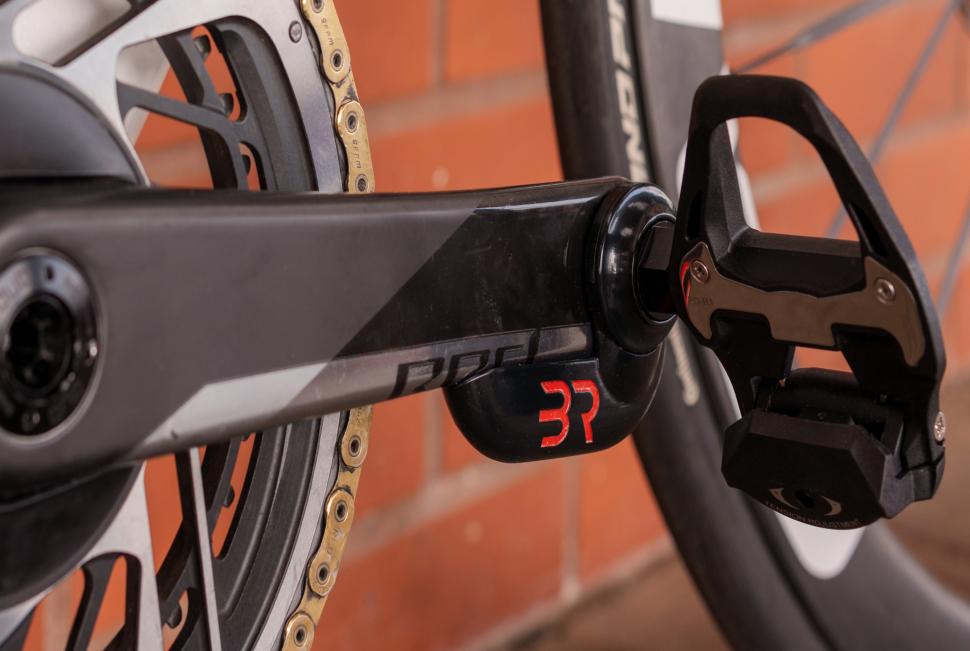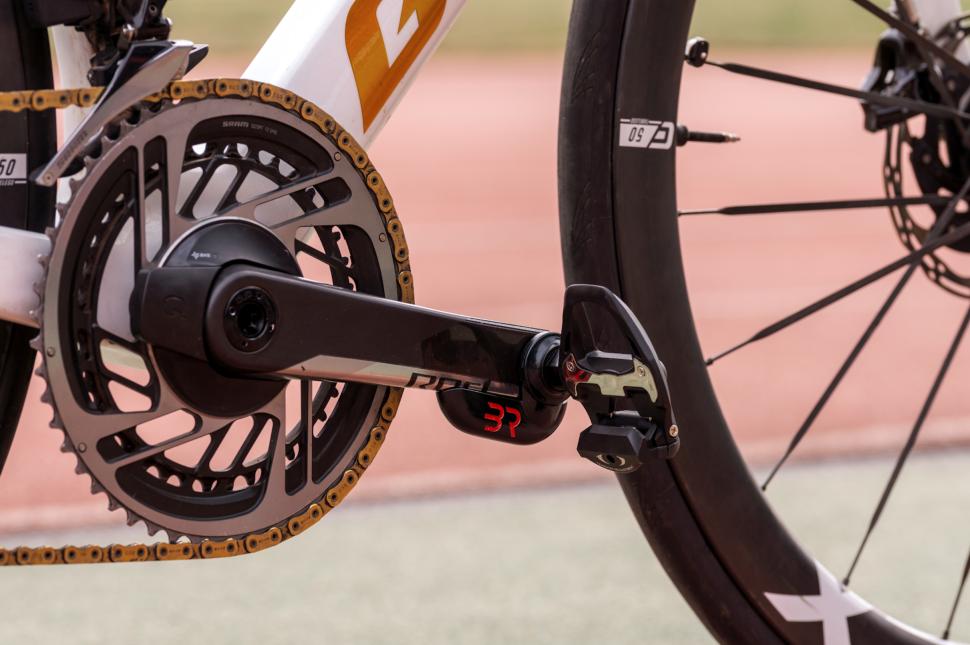- News
- Reviews
- Bikes
- Accessories
- Accessories - misc
- Computer mounts
- Bags
- Bar ends
- Bike bags & cases
- Bottle cages
- Bottles
- Cameras
- Car racks
- Child seats
- Computers
- Glasses
- GPS units
- Helmets
- Lights - front
- Lights - rear
- Lights - sets
- Locks
- Mirrors
- Mudguards
- Racks
- Pumps & CO2 inflators
- Puncture kits
- Reflectives
- Smart watches
- Stands and racks
- Trailers
- Clothing
- Components
- Bar tape & grips
- Bottom brackets
- Brake & gear cables
- Brake & STI levers
- Brake pads & spares
- Brakes
- Cassettes & freewheels
- Chains
- Chainsets & chainrings
- Derailleurs - front
- Derailleurs - rear
- Forks
- Gear levers & shifters
- Groupsets
- Handlebars & extensions
- Headsets
- Hubs
- Inner tubes
- Pedals
- Quick releases & skewers
- Saddles
- Seatposts
- Stems
- Wheels
- Tyres
- Health, fitness and nutrition
- Tools and workshop
- Miscellaneous
- Cross country mountain bikes
- Tubeless valves
- Buyers Guides
- Features
- Forum
- Recommends
- Podcast
TECH NEWS
 2025 Body Rocket power meter pedal
2025 Body Rocket power meter pedalBody Rocket launches the "world’s most accurate cycling power meter" claiming +/- 0.1% accuracy
Body Rocket, the aero tech start-up known for its real-time aerodynamic drag measurement system for cyclists and triathletes, has launched what it claims to be the "world's most accurate cycling power meter." The dual-sided power meter, a set of pedals that clip into any Shimano-style SPD-SL cleats, boasts a claimed accuracy of +/- 0.1% and is compatible with Body Rocket's drag force aero system. The pedals are available to pre-order now priced at £1,500.
At the end of last year, we tested another world-first innovation from Body Rocket - the "world's first real-time aerodynamic drag force measurement system for cyclists" - designed to measure drag without a wind tunnel, bringing DIY aero testing to cyclists and triathletes.
The Body Rocket system consists of sensors mounted on the seat post, stem, and pedals, streaming real-time aerodynamic drag force data to a Garmin head unit for post-session analysis.
Now, Body Rocket has introduced its own power meter pedals, which can be purchased separately or used alongside the aero system. The British brand says it developed the power meter "upon finding that current power meter offerings didn’t provide a high enough level of accuracy for the system’s precise requirements."
> The future of going fast? Why live drag sensors might be cycling's next big tech craze
Body Rocket's power meter pedals, claimed to be the most accurate cycling power meter in the world, boast a claimed accuracy of +/- 0.1% with a 20Hz sample rate. For comparison, some of the best power meters for cycling like the Garmin Rally pedals typically offer a claimed accuracy within +/- 1%, meaning Body Rocket's pedals have a claimed margin of error that is 10 times smaller.
Eric DeGolier, Body Rocket Founder and CEO, says: "Measuring aerodynamics is about 10x as hard as measuring power, so in building our own system we ended up with all the measurements needed for power at, unsurprisingly, about 10x the accuracy of most commercial systems.
"While we didn't initially set out to create the most accurate power meter on the market, the feedback we've received from our customers and community has made it clear there's a real demand."
According to Body Rocket, these accuracy claims have been independently verified by engineers at the Silverstone Sports Engineering Hub. For details on the verification process and the power meter's accuracy, you can find further information here.
The data is streamed to any ANT+ compatible head unit, and you can also send it to the Body Rocket app, which provides post-ride analysis at a sample rate of around 1Hz for more detailed insights into your power data.
Body Rocket's power meter pedals are dual-sided and rechargeable, with a claimed battery life of 40 hours, but they are only compatible with SPD-SL cleats.
Each pedal weighs a claimed 185g, making them slightly heavier than the Garmin Rally power meter pedals, which weigh 330g per pair (approximately 165g each). They also feature a standard 53mm spindle.
The Body Rocket power meter pedals are available for pre-order now at £1,500, with shipping expected in June 2025. Of course we're not able to test those accuracy claims yet, but we'll be looking to get a set of the pedals for ourselves to compare with the competition soon.
Emily is our track and road racing specialist, having represented Great Britain at the World and European Track Championships. With a National Title up her sleeve, Emily has just completed her Master’s in Sports Psychology at Loughborough University where she raced for Elite Development Team, Loughborough Lightning.
Emily is our go-to for all things training and when not riding or racing bikes, you can find her online shopping or booking flights…the rest of the office is now considering painting their nails to see if that’s the secret to going fast…
Latest Comments
- ubercurmudgeon 4 hours 26 min ago
I had three different cyclocross bikes before the marketing departments at various bicycle companies came up with the "gravel" category. All of...
- Sredlums 5 hours 10 min ago
Maybe the UK could try to reach some sort of agreement with the EU over things like international trade and such.
- David9694 5 hours 40 min ago
Cumbria County Council was a 1974 creation, merging the of old County Borough of Carlisle, and counties of Cumberland, and Westmorland - in which...
- Backladder 5 hours 52 min ago
If BC want to insist on barriers then they should have their own stock loaded on a truck that they can rent out to organisers at reasonable cost,...
- Miller 6 hours 22 min ago
Well, there's lifetime bans and there's lifetime bans. Banning an 88 year old don't impress me much.
- Gkam84 9 hours 27 min ago
I think that is why blind eyes have been turned in the UK, internationally aswell, with things like the Redhook crits, there were many licensed...
- mdavidford 10 hours 36 min ago
Ahem - other esporters(?) might be rather surprised to hear that the UCI has taken over their events - I think that would be the Cycling Esports...
- Bungle_52 10 hours 45 min ago
I wonder how he got to the game?
- OldRidgeback 10 hours 48 min ago
You'd need some good wet weather gear for that ride too.
- OnYerBike 13 hours 12 min ago
It seems to me that the most likely explanation is that whoever provided that quote fails to grasp the difference between a "public right of way"...




Add new comment
13 comments
Lovely kit but pointless for all but top pros with deep pockets and money no object. The extra grand is not buying the rest anything better than Assiomas etc which are fine for normal training. And indeed, most training requires relative measurement to highlight improvement, the absolute values are not quite so important. E racing slightly different but then that's not big money yet. So there's a thought - are they aimed at an emerging market? But that doesn't require the rest of the aero kit
Hard to fathom really.
What's the power meter they use to provide the reference figure against which they make the claims for this one? Surely the former must be the world's most accurate power meter?
Exactly what I was wondering. How do you KNOW how much it deviates. What kind of setup is used, what devices are used, and does that accurately simulate real usage?
Their /claim/ is they are much more accurate than any other retail power-meter. Given that claim, it would be a nonsense to use any competing, retail power-meter as a reference.
You'd need a lab with a calibrated test-rig evaluate their claim really. E.g., a system that applies a known load for a specific amount of time. A weight+gravity based system might work. Basically, you'd want to construct something where the input energy can easily be calculated using base measures (like weight) and physics, such that frictional losses in the delivery system are also readily apparent.
For a powermeter, you might also want to make the rate of load application vary somewhat with time. Sinusoidally with a weight+gravity system might be doable with some kind of off-centre mounted pulley/cog. Not sure...
Anyway, you need some way to very accurately apply a measurable amount of energy over time. Then you'd take your powermeter data, integrate it, and compare the energy the PM measured against your calculated input energy. With integration, error will accumulate, so your can measure your overall error more and more accurately with longer time scales (although, less and less accurate for instantaneous error).
I mainly use 10 second averaging so I can't see this super-'accuracy' being relevant to me. Of course, that's not to say it's no use to others
Assuming the error in a powermeter has some consistent bias (i.e., does not perfectly cancel out over time), the consistently biased portion of that error will be apparent in the powermeter reading regardless of the time frame.
I.e., if the 1s power is out consistently by +2%, then the 10s power will be too, mostly.
Shrugs
It would be interesting to see exactly what is meant by the "0.1% accuracy" claim as on the face of it Plot 2 on the link which is meant to describe the process doesn't seem to support this statement.
Pointless. Nobody - not even the Pro's - needs this level of accuracy and certainly not for 50% than most existing PM's.
For training, but how about for equipment testing? Is that new helmet more aerodynamic, which tires have better rolling resistance, if my drive train more efficient? At 300 watts 1% accuracy is + or - 3 watts, aka 6 watts range. So if you want to know if that helmet, tires, drivetrain etc is 5 watts better, you really need an accurate power meter, hence 0.1% or 0.6 watt range.
Impressive, but does it really matter?
I don't see 200W or 202W for the standard power meters 1% making?much a difference when training.
The primary use for such high accuracy (if precise) would mainly be for a Chung method based cda measurement system, where if you want a very precise and accurate output you need very high accuracy and precision inputs.
In his paper about his method, Prof. Robert Chung mentions that while you can get good estimates from somewhat lousy data, you can get extremely good values from very clean data
That's pretty impressive accuracy if true. For comparison, the best of the very expensive commercial torque meters I use at work (much larger, 10 000 N·m for engine testing) have a stated accuracy of ±0.03%.